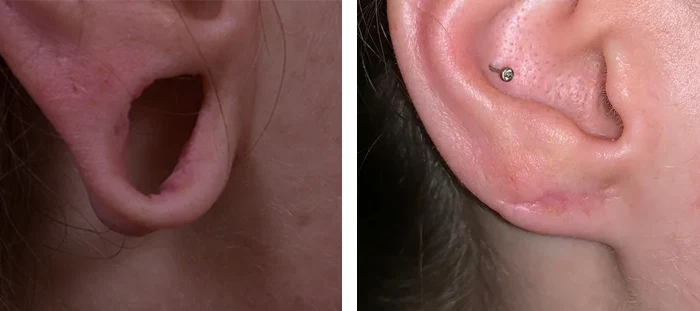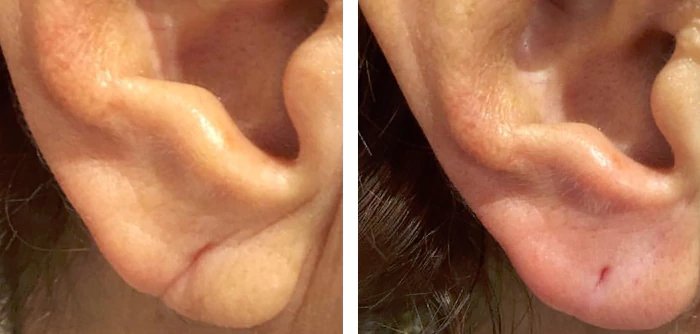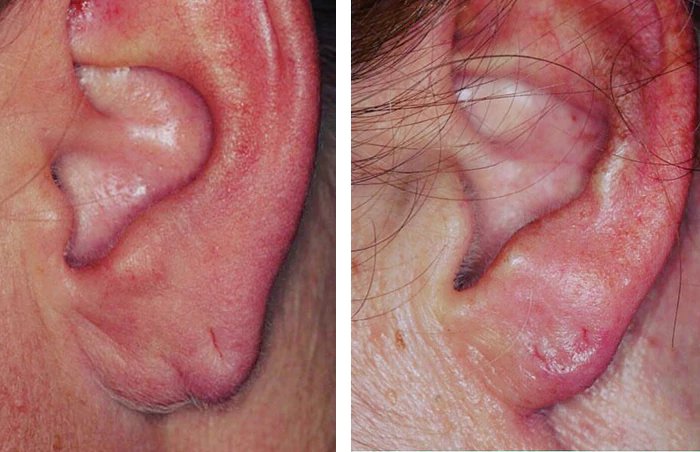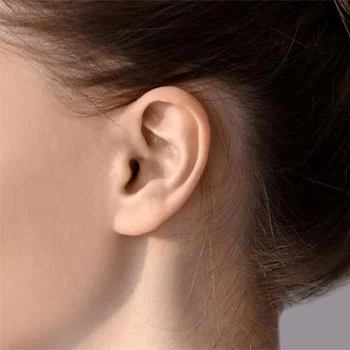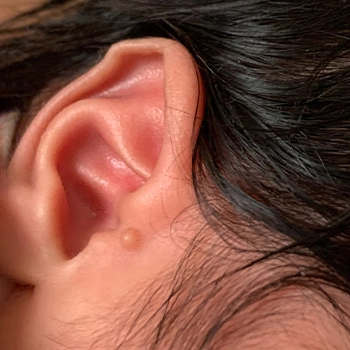What is Earlobe Repair Surgery?
Earlobe repair surgery or earlobe rejuvenation is a cosmetic procedure performed to address various concerns related to the earlobes. It involves reshaping, repairing, or rejuvenating the appearance of the earlobes to improve their aesthetic appeal or correct damage. It aims to restore the shape, structure, and appearance of the earlobes, typically focusing on repairing tears, deformities, or stretched piercings.
Who is Earlobe Repair Surgery For?
Earlobe repair surgery is suitable for individuals who have concerns or issues with their earlobes that require correction. The procedure is commonly performed for the following reasons:
Torn or split earlobes
One of the primary reasons individuals seek earlobe surgery is to address torn or split earlobes. This can occur due to accidental trauma, prolonged or heavy earring use, or stretching practices. Earlobe surgery can repair the tear by suturing the edges together, resulting in a restored and natural-looking earlobe.
Stretched or enlarged piercings
Some individuals may have stretched or enlarged earlobe piercings due to wearing large-gauge earrings or engaging in earlobe stretching practices. Earlobe surgery can involve removing excess or stretched tissue and reshaping the earlobe to more normal size and appearance.
Sagging or drooping earlobes
With age or due to factors like genetics or prolonged earring use, some individuals may experience sagging or drooping of the earlobes. This can be aesthetically undesirable or cause discomfort when wearing earrings. Earlobe surgery – in this case, called earlobe reduction surgery – can trim the earlobe and tighten the skin and underlying tissues, restoring a more youthful and lifted appearance to the earlobes.
Disproportionate or deformed earlobes
Some individuals may have naturally disproportionate or deformed earlobes, which can affect their overall facial aesthetics. Earlobe surgery can reshape the earlobes to create a more balanced and harmonious appearance, enhancing facial symmetry.
Keloid scarring
Keloid scars, characterized by raised and thickened scar tissue, can form on the earlobes following trauma or earlobe piercings. Earlobe surgery may be performed to remove the keloid scar tissue and improve the appearance of the earlobes.
Overall, earlobe surgery aims to address aesthetic concerns, restore symmetry, and improve the appearance of the earlobes. It can help individuals regain confidence, wear earrings comfortably, or simply achieve a more aesthetically pleasing look. It is important to consult with a qualified plastic surgeon or earlobe specialist to discuss individual concerns, evaluate candidacy, and determine the most suitable approach for achieving desired outcomes.
Who are not good candidates for earlobe surgery?
While earlobe repair surgery is generally safe and suitable for many individuals, there are certain cases where someone may not be an ideal candidate for the procedure. It's important to consult with a qualified plastic surgeon or earlobe specialist to assess your specific situation. Here are some factors that may make someone not suitable for earlobe repair surgery:
- Active Infections: If you have an active infection in the earlobe or surrounding area, it may be necessary to resolve the infection before considering surgery. Performing surgery in the presence of an infection can increase the risk of complications and hinder proper healing.
- Unrealistic Expectations: It is essential to have realistic expectations about the outcomes of earlobe repair surgery. While the procedure can address specific concerns and improve the appearance of the earlobes, it is important to understand that perfection cannot be guaranteed. If someone has unrealistic expectations, it may be necessary to reevaluate their candidacy for the surgery.
- Poor General Health: Individuals with underlying medical conditions or compromised immune systems may not be suitable candidates for earlobe repair surgery. It is crucial to have good overall health and be able to tolerate the surgery and the healing process. Pre-existing medical conditions should be discussed with the surgeon to determine the individual's suitability for the procedure.
- Healing Disorders: Certain medical conditions or medications can impair the body's ability to heal properly. Individuals with healing disorders, such as blood clotting disorders or conditions that affect tissue healing, may need to be evaluated on a case-by-case basis to determine their suitability for earlobe repair surgery.
- Insufficient Earlobe Tissue: In some cases, if the earlobe tissue is severely damaged or has insufficient tissue for repair, it may not be possible to achieve satisfactory results through surgery alone. The surgeon will assess the amount and quality of available tissue to determine the feasibility of the procedure.
It is crucial to have a comprehensive consultation with a qualified surgeon who can evaluate your specific situation, discuss your medical history, and assess your candidacy for earlobe repair surgery. They will consider various factors to ensure the procedure is safe and suitable for you, providing personalized recommendations based on your individual circumstances.
How is Earlobe Repair Surgery Performed?
Earlobe repair surgery is typically performed as an outpatient procedure and involves the following steps:
- Anesthesia: The surgeon will administer local anesthesia to numb the earlobe area. This ensures that the patient remains comfortable throughout the procedure.
- Cleaning and Marking: The surgeon will clean the earlobe area with an antiseptic solution to minimize the risk of infection. They will then mark the areas where the incisions will be made to repair the earlobe.
- Incisions: The surgeon will make precise incisions along the edges of the torn or damaged earlobe. The length and shape of the incisions will depend on the type and extent of the damage being addressed.
- Tissue Removal and Repair: The next step involves removing any excess tissue or scar tissue and carefully aligning the edges of the torn or damaged earlobe. The surgeon will then use fine sutures to close the incisions, ensuring a secure and natural-looking repair.
- Dressing and Aftercare: Once the sutures are in place, the surgeon will apply a sterile dressing to protect the repair site. They will provide instructions on how to care for the earlobe during the recovery period, which may involve keeping the area clean, avoiding excessive pressure or tension, and refraining from wearing earrings for a specified time.
The entire procedure typically takes around 30 minutes to an hour, depending on the complexity of the repair. The sutures used are often dissolvable, eliminating the need for suture removal in most cases.
What is Earlobe Surgery Recovery Like?
After earlobe repair surgery, patients can generally return home on the same day. Mild discomfort, swelling, and bruising may be experienced in the first few days following the procedure. Pain medication and cold compresses can help manage any discomfort. It is important to follow the post-operative instructions provided by the surgeon, which may include avoiding activities that may strain the earlobe and keeping the area clean to promote proper healing.
The recovery period for earlobe repair surgery is relatively short, with most individuals able to resume normal activities within a few days. Here is an overview of what to expect during the recovery phase:
- Immediate Postoperative Period: After the surgery, the earlobe may feel numb due to the local anesthesia. Some mild discomfort, swelling, and bruising in the treated area can be expected. The surgeon may apply a sterile dressing to protect the surgical site.
- Pain Management: Over-the-counter pain medication, as recommended by the surgeon, can help manage any discomfort during the initial days following the procedure. Applying cold compresses to the area may also help reduce swelling and alleviate discomfort.
- Healing and Sutures: The sutures used in earlobe repair surgery are typically dissolvable, so there is no need for suture removal. The incision site will gradually heal over time. It is important to avoid touching or picking at the sutures to allow for proper healing.
- Postoperative Care: The surgeon will provide specific postoperative care instructions. This may include keeping the area clean and dry, avoiding excessive pressure or tension on the earlobe, and refraining from wearing earrings for a certain period. It is crucial to follow these instructions to promote proper healing and reduce the risk of complications.
- Swelling and Bruising: Swelling and bruising are common after earlobe repair surgery but should gradually diminish within a few days to a week. Keeping the head elevated and applying cold compresses can help reduce swelling and bruising.
- Return to Normal Activities: Most individuals can resume their normal activities within a few days after the surgery. However, it is important to avoid activities that may strain or put pressure on the earlobe during the initial healing period. The surgeon will provide guidance on when it is safe to resume wearing earrings.
- Follow-up Appointments: The surgeon will schedule follow-up appointments to monitor the healing progress and remove any remaining sutures if necessary. These appointments allow the surgeon to ensure that the earlobe is healing properly and address any concerns that may arise.
The exact recovery timeline can vary from person to person, but generally, within a few weeks, the earlobe should be well on its way to healing. It is important to communicate with the surgeon and seek their guidance if there are any unexpected or concerning symptoms during the recovery period.
Remember that everyone's healing process is unique, so it is essential to follow the specific instructions provided by the surgeon to promote optimal healing and achieve the desired results.
What Are the Potential Risks and Complications?
Like any surgical procedure, earlobe repair surgery carries certain risks and potential complications. While complications are relatively rare, it is important to be aware of the potential risks involved. These risks may include:
- Infection: Although precautions are taken to minimize the risk of infection, there is still a small possibility of developing an infection at the incision site. Signs of infection may include increased pain, redness, swelling, or drainage. It is important to follow post-operative care instructions and contact the surgeon if any signs of infection occur.
- Bleeding or Hematoma: Excessive bleeding or the formation of a hematoma (a collection of blood) can occur after earlobe repair surgery. While this is uncommon, it may require medical attention to address the issue.
- Poor Healing or Scarring: In some cases, the earlobe may not heal properly or may result in visible scarring. Factors such as individual healing abilities, pre-existing conditions, or improper aftercare can contribute to poor healing or scarring.
- Changes in Sensation: Temporary or permanent changes in sensation, such as numbness or altered sensitivity, may occur around the surgical area. Most often, sensation returns to normal over time, but in rare cases, it may be permanent.
- Allergic Reaction: Some individuals may have an allergic reaction to the anesthesia, sutures, or other materials used during the surgery. It is important to inform the surgeon of any known allergies or sensitivities beforehand.
- Keloid Formation: Individuals with a predisposition to keloid scarring may be at an increased risk of developing keloid scars following earlobe repair surgery. Keloid scars are raised, thickened scars that extend beyond the boundaries of the original wound.
- Asymmetry or Unfavorable Results: While efforts are made to achieve symmetrical and aesthetically pleasing results, there is a possibility of asymmetry or dissatisfaction with the outcome of the surgery. It is important to have realistic expectations and communicate your goals clearly with the surgeon during the consultation.
It is crucial to consult with a qualified plastic surgeon or earlobe specialist who can assess your individual situation, discuss the potential risks, and provide personalized recommendations. By carefully following the surgeon's instructions and attending follow-up appointments, you can minimize the risks and increase the likelihood of a successful outcome.
Earlobe Surgery Cost
The cost of earlobe repair surgery can vary depending on several factors, including the complexity of the repair, the geographic location of the surgical facility, the surgeon's experience and expertise, and any additional fees associated with anesthesia, facility fees, and post-operative care. It is important to note that the costs mentioned here are approximate and may vary.
On average, the cost of earlobe repair surgery can range from $500 to $1000 per earlobe. This estimate typically includes the surgeon's fee, anesthesia fees, and facility fees. However, it is essential to consult with a plastic surgeon or earlobe specialist to obtain an accurate cost estimate based on your specific needs and circumstances.
Factors that can influence the cost of earlobe repair surgery include:
- Complexity of the Repair: The extent of the damage to the earlobe and the complexity of the repair required can affect the cost. More extensive repairs may require additional time and expertise, which can contribute to higher costs.
- Surgeon's Experience and Expertise: Highly experienced and reputable surgeons may charge higher fees for their services. It is important to choose a qualified and board-certified plastic surgeon or earlobe specialist who has a track record of successful earlobe repairs.
- Geographic Location: The cost of living and healthcare varies by region, which can influence the overall cost of the procedure. Generally, urban areas or regions with higher costs of living tend to have higher surgical fees.
- Additional Fees: In addition to the surgeon's fee, there may be additional fees associated with anesthesia, facility usage, and post-operative care. It is important to inquire about these fees during the consultation to have a clear understanding of the total cost.
Insurance coverage for earlobe repair surgery is typically limited as it is considered an elective cosmetic procedure. However, it is advisable to check with your insurance provider to determine if there are any specific circumstances under which coverage may be available.
During the consultation, the surgeon will provide a breakdown of the costs involved and discuss payment options and financing plans, if available. It is important to prioritize the selection of a qualified surgeon based on their expertise and reputation rather than solely focusing on cost. The quality and safety of the procedure should always be the primary consideration.
Frequently Asked Questions
When can I re-pierce my ears after earlobe surgery?
In general, it is advisable to wait until the earlobe has fully healed before re-piercing. This typically takes several weeks to a few months, depending on the extent of the repair and the individual's healing rate. During this time, the earlobe needs to regain its strength and stability to ensure a successful re-piercing without compromising the results of the surgery.
Is earlobe repair surgery painful?
Earlobe repair surgery is typically performed under local anesthesia, which numbs the area, minimizing discomfort during the procedure. Some mild discomfort or soreness may be experienced during the recovery period.
How long does earlobe repair take?
The duration of earlobe repair surgery can vary depending on the complexity of the repair. Generally, the procedure takes around 30 minutes to an hour.
Will earlobe surgery leave scars on my ear?
Earlobe repair surgery may leave minimal, well-hidden scars. The surgeon will make incisions in inconspicuous areas and use suturing techniques to minimize visible scarring. Over time, the scars tend to fade and become less noticeable.
When is it safe to start wearing earrings again after earlobe repair?
The timing for re-piercing the ears after earlobe repair surgery varies depending on the individual's healing progress. Typically, it is advisable to wait until the earlobe has fully healed, which can take several weeks to a few months. Consult with your surgeon for personalized recommendations.
Is it possible to have detached earlobes reattached?
Yes, it is possible to have detached earlobes reattached through a surgical procedure called earlobe reattachment or earlobe reconstruction.
Can stretched earlobes revert to their original shape without surgery?
No, stretched earlobes typically do not revert to their original shape without surgical intervention.
What's the reason for wrinkled earlobes?
Wrinkled earlobes can be caused by factors such as aging, loss of skin elasticity, sun damage, or genetic predisposition.

